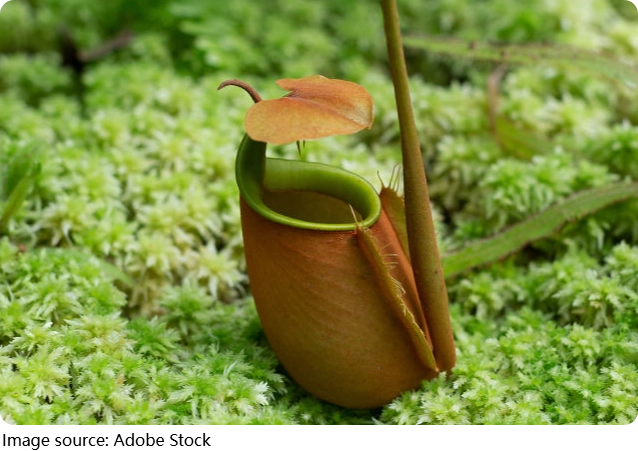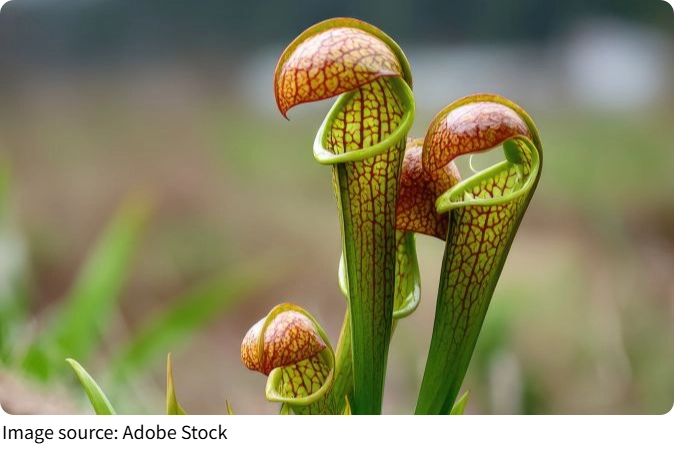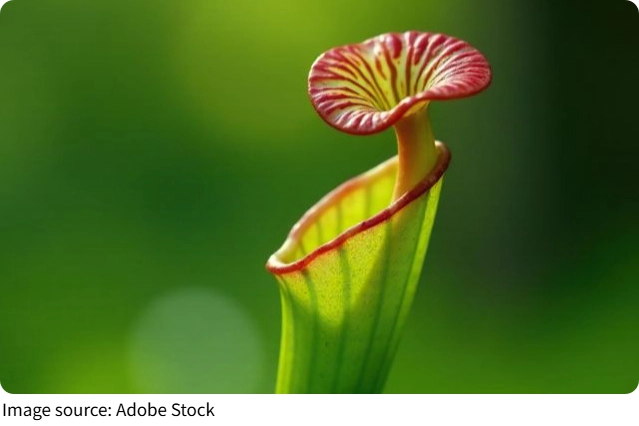The Face in the Marsh

If you wander through a cool, boggy meadow in northern California or Oregon, you might notice a cluster of tall, green stalks with strange hoods at the top—shapes that look uncannily like hooded faces.
This is Darlingtonia californica, better known as the cobra lily, one of the most visually striking carnivorous plants in the world. Its look is intriguing enough, but the real fascination lies in how it uses light, scent, and design to trap unsuspecting insects.
The Mystery of the "Face"
Darlingtonia gets its common name from its resemblance to a cobra poised to strike—arched neck, flared hood, and even reddish "tongue-like" appendages. To some, the pattern of light and shadow inside the hood gives the illusion of a face. But the "expression" is not for human eyes; it's a sophisticated trap that plays tricks on insects.
Inside the hood are translucent patches called fenestrations—thin spots in the leaf tissue that let light through. To an insect inside, these look like possible escape routes. The catch? They're false exits. As the insect flies or crawls toward the light, it bumps into smooth, waxy walls and eventually tumbles into the downward tunnel leading to the trap chamber.

The Deceptive Pathway
Darlingtonia's trap is different from the digestive pools of pitcher plants like Nepenthes. Instead of drowning prey in a static liquid, the cobra lily uses running water inside its tubular leaf. This makes it harder for insects to swim back out, as the current pushes them deeper.
The entire process works like this:
1. Attraction – The plant produces a faint scent, sometimes slightly sweet, that draws in flies, ants, and beetles.
2. Disorientation – Light streaming through the fenestrations misleads the insect into moving the wrong way.
3. Entrapment – Smooth surfaces and downward hairs prevent climbing back up.
4. Digestion – The prey is carried into the fluid-filled base, where microbes and enzymes break it down.
Botanist Dr. Barry Rice, who has studied Darlingtonia in its native habitat, points out that this design uses "visual illusion and structural engineering more than brute force," making it one of the most energy-efficient insect traps in the plant kingdom.
Why Running Water Matters?
The use of flowing water in its trap chamber is rare among carnivorous plants. This adaptation may help Darlingtonia survive in the cold, oxygen-rich mountain springs where it grows. The running water prevents the buildup of stagnant bacteria that could harm the plant, while still allowing digestive microbes to thrive. It's a fine balance—too much water flow and the prey would be washed away, too little and the chamber could rot.
Growing Cobra Lilies at Home
If you're tempted to keep this eerie beauty in your garden, be prepared for a challenge. Darlingtonia is notoriously picky about its conditions:
1. Cool Roots: It prefers cold, running water around its roots, mimicking its natural mountain spring habitat.
2. Soil: Needs nutrient-poor, acidic soil such as sphagnum moss or peat-sand mix.
3. Light: Enjoys full sun but must avoid root overheating.
4. Feeding: Outdoors, it catches enough insects; indoors, it may require occasional small prey.
Because of these needs, cobra lilies are more for dedicated plant enthusiasts than for casual houseplant keepers.

Lessons from the Marsh
The cobra lily's success shows that in nature, survival isn't always about being the fastest or strongest—it's about being the most deceptive. By blending visual trickery, flowing water traps, and false exits, Darlingtonia turns a nutrient-poor bog into a thriving hunting ground.
For scientists, it's also a case study in how complex strategies can evolve without a brain or muscles—just the right shapes, textures, and environmental tuning. As Dr. Rice notes, "Darlingtonia isn't hunting with intention, but its design accomplishes the same goal as a predator's strategy."
Would You Step Closer?
The next time you see a cobra lily's hooded form swaying in a cold spring breeze, you might feel it's watching you. That "face" isn't alive in the way we think—but for the insects it lures, it might as well be a predator's gaze.
Would you lean in to look closer, knowing that what you're staring at is one of nature's most artful traps? Some things in the wild are beautiful because they're deadly—and the cobra lily is a master at both.
-
 Master Cruise ControlLearn simple habits to use cruise control safely and stress-free.
Master Cruise ControlLearn simple habits to use cruise control safely and stress-free. -
 Skiing Safe and SmartMost ski injuries are preventable — here’s how to stay safe on the slopes this winter
Skiing Safe and SmartMost ski injuries are preventable — here’s how to stay safe on the slopes this winter -
 Amblyopia: Must Know!Could Vision Be Weak In One Eye? Learn How Amblyopia Shows And How To Protect Sight Fast!
Amblyopia: Must Know!Could Vision Be Weak In One Eye? Learn How Amblyopia Shows And How To Protect Sight Fast!